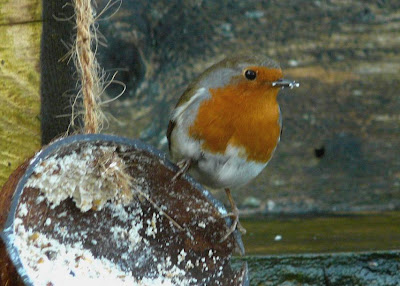Robins do not allow other Robins on their patch and will defend their territory to the death if necessary. Only in spring will they allow other members of their own specie onto their patch;
In 2008, four Robins were using the garden as their feeding station, each careful not to appear out in the open when any of the others were feeding already. At one time, I spotted all four on my gardenwall asd it was fascinating to watch them change place- giving each a chance to peck at the other and make clear what his/her was position in the garden was. During the summer I only saw two of them; the pair which was breeding nearby.
After the breeding season, and after the moult, Robins will again defend their territory and let other Robins know that this is his or her feeding ground.
This Robin I found in the garden yesterday. Looking more closely, it was obvious that there were no wounds, injuries or other sign of predatory action, and it was clear that it had died without the aid of cats/dogs or any other predator.
 Thing back to wat I'd seen that day, I recalled the three Robins I'd spotted during the day. Two had been trying to feed without alerting the other Robin.
Thing back to wat I'd seen that day, I recalled the three Robins I'd spotted during the day. Two had been trying to feed without alerting the other Robin.Then, with one Robin at the planter and another one in the black bin of the Fatsia (next to each other) I remembered seeing another Robin fly in from the back of the house, passing the window. I remembered this, as this was an unusual way to enter the garden and planter, and also that one of the other Robins took to the air too, flying towards the wall of the kitchen. and into the fly-path of the other Robin already airborne. I am convinced that it was this Robin which killed my poor dead friend. Not really know how, but then, I did see one Robin go after, and attack another Robin, here in the garden, at some time in 2007 or 2008. I didn't see any of it, because it all just happened behind the little wall between the kitchen window and the window of the kitchendoor. A width of say 1,10, or 1.15 at most.
Here's a few photos of my Robins;
Robin, Erithacus rubecula


 balancing exercises
balancing exercises

The Robin is most people's favourite bird; not so with me. The juvenile Robin however, is a gorgeous bird, with its rusty speckled coat. This one has already starting to moult into its adult plumage. (as you can see on the whitish underbelly. )

.

There was one witness; getting details from him/her is a trial in itself!
Coal Tit, Parus ater












































